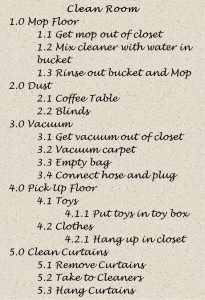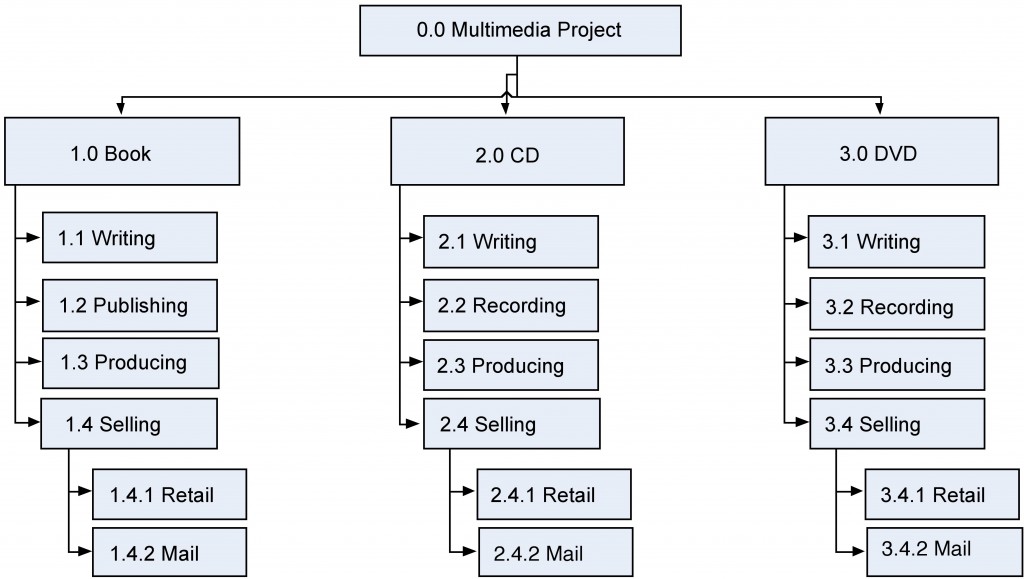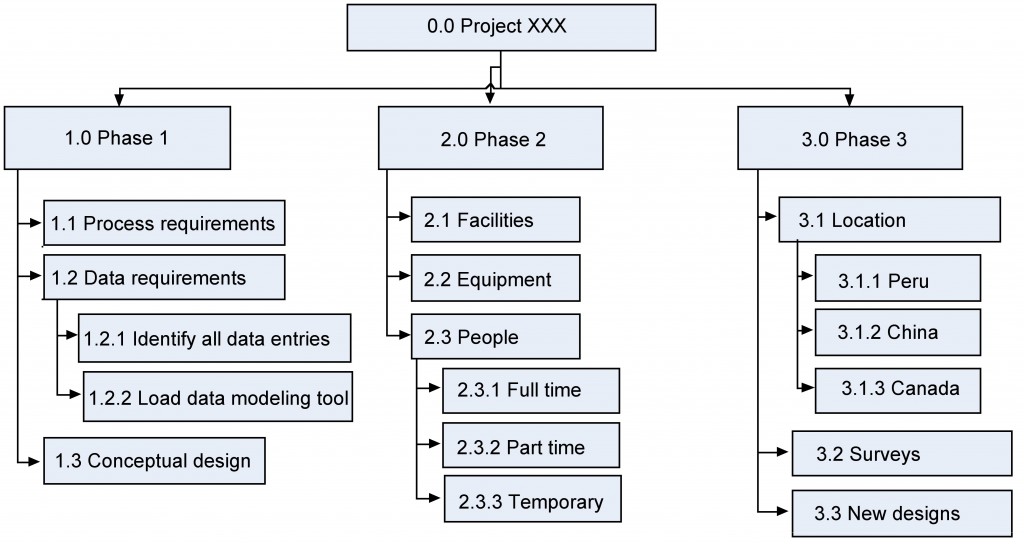34 Work Breakdown Structure
Work Breakdown Structure
Now that we have the deliverables and requirements well defined, the process of breaking down the work of the project via a work breakdown structure (WBS) begins. The WBS defines the scope of the project and breaks the work down into components that can be scheduled, estimated, and easily monitored and controlled.
The WBS is a hierarchical outline of all the deliverables involved in completing a project. The WBS is part of a project scope statement. The creation of a WBS is one of the first steps in organizing and scheduling the work for a project. The WBS is a breakdown of a project into sub-deliverables and eventually work-packages. Each level of the WBS, represents more detailed information about a project. Figure 5-1 shows how the project is broken down into major deliverables and then into sub-deliverables and work packages.
The idea behind the WBS is simple: you subdivide a complicated task into smaller tasks, until you reach a level that cannot be further subdivided. Anyone familiar with the arrangements of folders and files in a computer memory or who has researched their ancestral family tree should be familiar with this idea. You stop breaking down the work when you reach a low enough level to perform an estimate of the desired accuracy. At that point, it is usually easier to estimate how long the small task will take and how much it will cost to perform than it would have been to estimate these factors at the higher levels. Each descending level of the WBS represents an increased level of detailed definition of the project work.
WBS describes the products or services to be delivered by the project and how they are decomposed and related. It is a deliverable-oriented decomposition of a project into smaller components. It defines and groups a project’s discrete work elements in a way that helps organize and define the total work scope of the project.
A WBS also provides the necessary framework for detailed cost estimating and control, along with providing guidance for schedule development and control.
Overview
WBS is a hierarchical decomposition of the project into phases, deliverables, and work packages. It is a tree structure, which shows a subdivision of effort required to achieve an objective (e.g., a program, project, and contract). In a project or contract, the WBS is developed by starting with the end objective and successively subdividing it into manageable components in terms of size, duration, and responsibility (e.g., systems, subsystems, components, tasks, subtasks, and work packages), which include all steps necessary to achieve the objective.
The WBS creation involves:
- Listing all the project outputs (deliverables and other direct results)
- Identifying all the activities required to deliver the outputs
- Subdividing these activities into subactivities and tasks
- Identifying the deliverable and milestone(s) of each task
- Identifying the time usage of all the resources (personnel and material) required to complete each task
The purpose of developing a WBS is to:
- Allow easier management of each component
- Allow accurate estimation of time, cost, and resource requirements
- Allow easier assignment of human resources
- Allow easier assignment of responsibility for activities
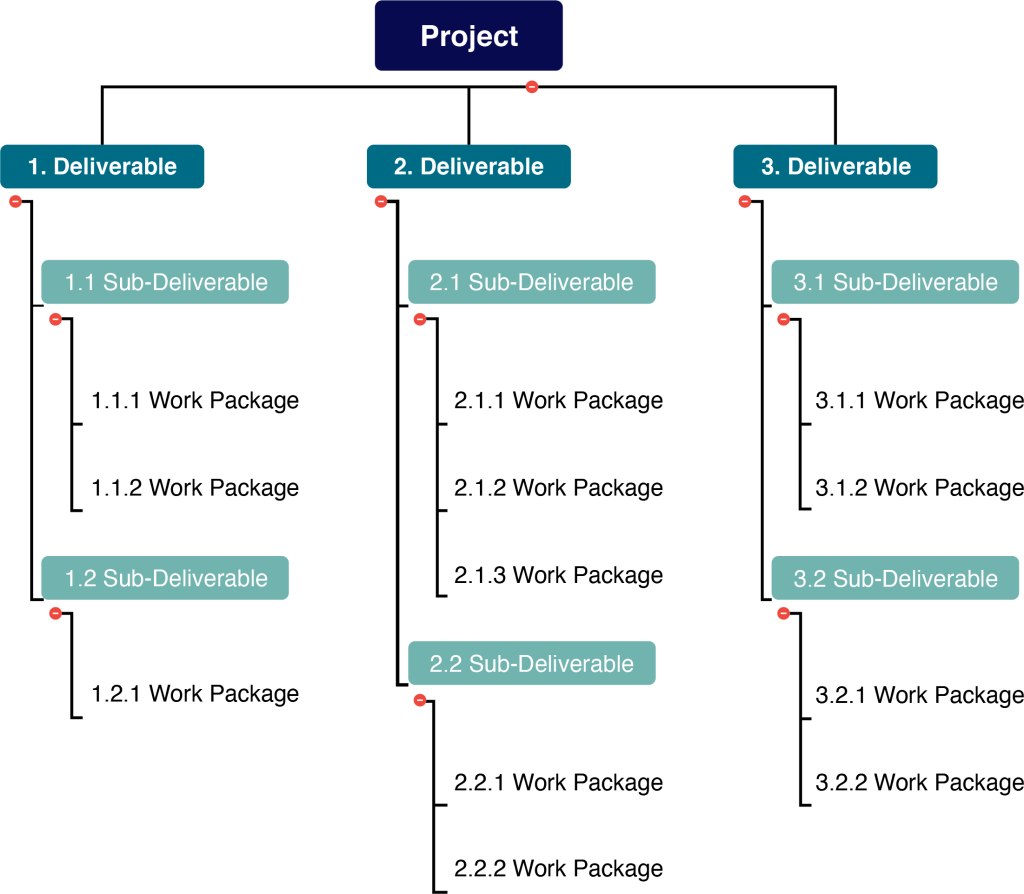
Above figure is an outline that shows how the deliverables, sub-deliverables and work packages relate to the final project.
Example of a WBS
If I want to clean a room, I might begin by picking up clothes, toys, and other things that have been dropped on the floor. I could use a vacuum cleaner to get dirt out of the carpet. I might take down the curtains and take them to the cleaners, and then dust the furniture. All of these tasks are subtasks performed to clean the room. As for vacuuming the room, I might have to get the vacuum cleaner out of the closet, connect the hose, empty the bag, and put the machine back in the closet. These are smaller tasks to be performed in accomplishing the subtask called vacuuming. Figure 9.3 shows how this might be portrayed in WBS format.
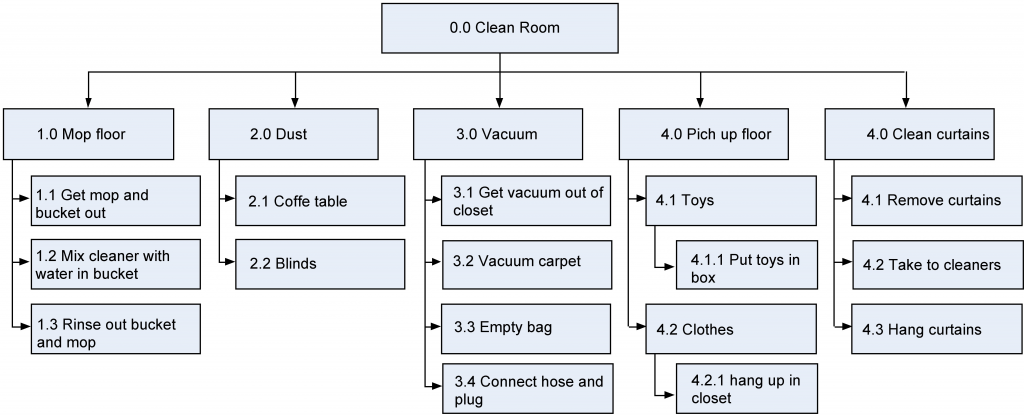
It is very important to note that we do not worry about the sequence in which the work is performed or any dependencies between the tasks when we do a WBS. That will be worked out when we develop the schedule. For example, under 3.0 Vacuum, it would be obvious that 3.3 Vacuum carpet would be performed after 3.4 Connect hose and plug! However, you will probably find yourself thinking sequentially, as it seems to be human nature to do so. The main idea of creating a WBS is to capture all of the tasks, irrespective of their order. So if you find yourself and other members of your team thinking sequentially, don’t be too concerned, but don’t get hung up on trying to diagram the sequence or you will slow down the process of task identification. A WBS can be structured any way it makes sense to you and your project. In practice, the chart structure is used quite often but it can be composed in outline form as well (Figure 9.4).
You’ll notice that each element at each level of the WBS in both figures is assigned a unique identifier. This unique identifier is typically a number, and it’s used to sum and track costs, schedules, and resources associated with WBS elements. These numbers are usually associated with the corporation’s chart of accounts, which is used to track costs by category. Collectively, these numeric identifiers are known as the code of accounts.
There are also many ways you can organize the WBS. For example, it can be organized by either deliverable or phase. The major deliverables of the project are used as the first level in the WBS. For example, if you are doing a multimedia project the deliverables might include producing a book, CD, and a DVD (Figure 9.5).
Many projects are structured or organized by project phases (Figure 9.6). Each phase would represent the first level of the WBS and their deliverables would be the next level and so on.
The project manager is free to determine the number of levels in the WBS based on the complexity of the project. You need to include enough levels to accurately estimate project time and costs but not so many levels that are difficult to distinguish between components. Regardless of the number of levels in a WBS, the lowest level is called a work package.
Work packages are the components that can be easily assigned to one person or a team of people, with clear accountability and responsibility for completing the assignment. The work-package level is where time estimates, cost estimates, and resource estimates are determined.
100 Percent Rule
The 100 percent rule is the most important criterion in developing and evaluating the WBS. The rule states that each decomposed level (child) must represent 100 percent of the work applicable to the next higher (parent) element. In other words, if each level of the WBS follows the 100 percent rule down to the activities, then we are confident that 100 percent of the activities will have been identified when we develop the project schedule. When we create the budget for our project, 100 percent of the costs or resources required will be identified.
Text Attributions
This chapter of Project Management is a derivative of the following texts:
- Work Breakdown Structure by Wikipedia. © CC BY-SA (Attribution-ShareAlike).
- 100 Percent Rule by Pabipedia. © CC BY-SA (Attribution-ShareAlike).
Media Attributions
- WBS Cleaning Room by Barron & Barron Project Management for Scientists and Engineers © CC BY (Attribution)
- WBS Outline – Clean Room by Barron & Barron Project Management for Scientists and Engineers © CC BY (Attribution)
- Multimedia Project WBS by Barron & Barron Project Management for Scientists and Engineers © CC BY (Attribution)
- WBS Project Phases by Barron & Barron Project Management for Scientists and Engineers © CC BY (Attribution)

